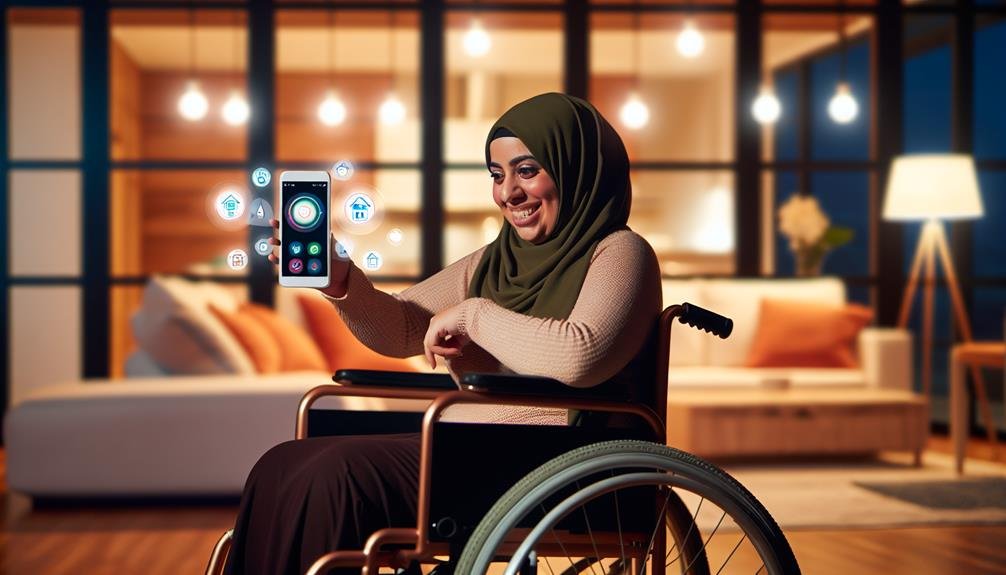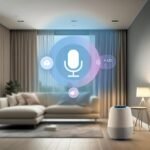Imagine a world where your home anticipates your needs and effortlessly adapts to accommodate your unique abilities. Smart home automation is revolutionizing the way individuals with disabilities interact with their living spaces, providing newfound freedom and independence.
From voice-activated control systems that respond to your every command, to motion sensor technology that detects your presence and adjusts accordingly, the possibilities are endless. But it doesn't stop there.
In this discussion, we will explore the incredible advancements in smart home automation, uncovering how customizable accessibility solutions, improved safety measures, and a range of smart appliances and devices are transforming the lives of individuals with disabilities.
Get ready to discover a future where your home becomes more than just a dwelling – it becomes an empowering ally in your daily life.
Key Takeaways
- Voice-activated control systems and motion sensor technology offer convenient and hands-free control of smart home devices, providing increased independence for individuals with disabilities.
- Integration with a wide range of compatible smart devices and customizable accessibility solutions allows for personalized automation and easy access and maneuverability.
- Smart appliances and devices, along with remote monitoring and control capabilities, offer individuals with mobility issues the ability to manage their home environment from anywhere.
- Improved safety and security measures, such as emergency response systems and linking sensors to notify emergency services, enhance protection and provide peace of mind in a smart home environment.
Voice-Activated Control Systems
Are you looking for a convenient and hands-free way to control your smart home devices? Voice-activated control systems offer just that. With voice recognition technology and virtual assistants, you can effortlessly manage your smart home with the power of your voice.
Voice recognition technology allows your smart home to understand and respond to your commands. By simply speaking to your virtual assistant, you can control various aspects of your home, such as adjusting the temperature, turning on lights, or even playing music. No more fumbling with buttons or struggling to reach switches – just speak, and your smart home will follow your instructions.
Virtual assistants, like Amazon Alexa or Google Assistant, act as the central hub for your voice-activated control system. These intelligent software platforms not only recognize and interpret your commands but also provide additional functionalities. They can answer questions, provide weather updates, set reminders, and even order groceries for you. With a wide range of compatible smart devices, virtual assistants offer seamless integration and make managing your smart home a breeze.
Voice-activated control systems provide freedom and convenience for individuals with disabilities. By eliminating the need for physical interaction, these systems empower users to effortlessly control their smart home devices, making their lives easier and more accessible.
Motion Sensor Technology
Motion sensor technology offers a convenient and automated way to control your smart home devices. With gesture recognition and advanced analytics, motion sensors can enhance accessibility for individuals with disabilities.
Here are four key benefits of motion sensor technology:
- Hands-free control: Motion sensors allow you to interact with your smart home devices without the need for physical buttons or touchscreens. By simply waving your hand or making specific gestures, you can control lights, thermostats, and other devices.
- Increased independence: For individuals with disabilities, motion sensor technology can provide a greater sense of freedom and autonomy. Instead of relying on assistance or specialized equipment, they can easily navigate their home environment and perform daily tasks independently.
- Energy efficiency: Motion sensors can detect when a room is occupied or empty, automatically adjusting lighting and temperature settings accordingly. This not only saves energy but also reduces utility costs, making your smart home more sustainable and cost-effective.
- Personalized automation: Motion sensors can be integrated with advanced analytics to learn your behavior patterns and preferences. This allows for personalized automation, where your smart home devices anticipate your needs and adjust settings based on your habits and routines.
Smart Appliances and Devices
Smart appliances and devices offer a seamless and efficient way to automate your home and enhance accessibility for individuals with disabilities. These advanced technologies provide customizable accessibility solutions, improved safety and security measures, and energy-efficient features. With voice-activated control systems and integration with wearable devices, you have the freedom to control your home environment effortlessly.
One of the key features of smart appliances and devices is their integration with motion sensor technology. This means that they can detect your movements and perform tasks accordingly. For example, a smart oven can turn off automatically when it senses that you have left the kitchen, preventing any accidents.
In addition to motion sensor technology, these devices also offer remote monitoring and control capabilities. This means that you can check the status of your appliances and adjust settings from anywhere using your smartphone or tablet. This feature is particularly beneficial for individuals with disabilities who may have limited mobility.
To give you a better understanding, here is a table showcasing some of the features and benefits of smart appliances and devices:
| Features | Benefits |
|---|---|
| Voice-activated control systems | Hands-free control for individuals with mobility issues |
| Customizable accessibility solutions | Tailored settings to meet specific needs |
| Improved safety and security measures | Ensures a secure and protected living environment |
| Energy-efficient features | Reduces energy consumption and saves money |
| Integration with wearable devices | Seamless integration with wearable technology |
| Remote monitoring and control capabilities | Easy access and control from anywhere |
With smart appliances and devices, you can enjoy the freedom and independence of controlling your home environment effortlessly while enhancing accessibility for individuals with disabilities.
Customizable Accessibility Solutions
Enhance accessibility and tailor your home environment with customizable solutions for individuals with disabilities. By incorporating adjustable furniture and assistive technology, you can create a space that meets your unique needs and promotes independence. Here are four customizable accessibility solutions to consider:
- Adjustable Furniture: Invest in furniture that can be easily adjusted to accommodate different heights, angles, and positions. This includes adjustable beds, desks, and chairs that can be modified to provide optimal comfort and support.
- Assistive Technology: Explore the wide range of assistive technology available for individuals with disabilities. From voice-activated smart home devices to environmental control systems, these technologies can help you control and automate various aspects of your home, such as lighting, temperature, and entertainment systems.
- Customized Accessibility Features: Work with professionals to customize your home's accessibility features. This could involve installing ramps, widening doorways, or adding grab bars in bathrooms to ensure easy access and maneuverability.
- Personalized Smart Home Automation: Take advantage of smart home automation systems that can be tailored to your specific needs. These systems can be programmed to respond to voice commands, remote controls, or even customized interfaces, allowing you to control various devices and appliances throughout your home effortlessly.
Improved Safety and Security Measures
When it comes to improving safety and security in a smart home, there are several features that can be incorporated to provide peace of mind and enhanced protection. One such measure is the inclusion of emergency response systems. These systems can be linked to various sensors and detectors throughout the home, such as smoke detectors and motion sensors, and can automatically notify emergency services in the event of a fire, break-in, or medical emergency. This ensures that help is dispatched quickly, even if the individual is unable to call for assistance themselves.
Additionally, smart homes can offer remote monitoring capabilities, allowing caregivers or family members to keep an eye on the home and its occupants from anywhere. This can include features like video surveillance, door and window sensors, and even the ability to remotely lock or unlock doors. These measures not only provide a sense of security, but also allow individuals with disabilities to maintain their independence and freedom, knowing that help is readily available when needed.






